For decades, the joint symbolized defiance and dissent. Whether you were protesting the Vietnam War or railing against income inequality with the Occupy Movement, people were smoking cannabis.
Today, we’re witnessing marijuana culture shift away from its counter-culture roots and become more assimilated into mainstream society. What will these changes mean for the future of cannabis? Will mass commercialization take all the fun out of smoking weed?
How Cannabis Became Associated With Counter Culture To Begin With

The intersection of cannabis and iconoclasm dates back over 100 years ago, during the Jazz Age. When the younger generation thinks of Jazz, often they think of Kenny G’s painfully sharp smooth jazz, or perhaps the dulcet tones of Muzak pumped into the waiting room of a dentist’s office. However, this perception of Jazz as milquetoast background sounds made for retirement communities and call center hold music is a recent phenomenon.
Jazz originated in the bordellos of New Orleans among African American’s, and it continued to be the soundtrack of sordid enterprise and hedonism for decades. It’s not dissimilar to the way hip-hop began as an underground movement before being co-opted by top 40 hitmakers.
Jazz musicians were, in a word, cool. They seemed to exist in an alternate reality to the conservative mainstream nuclear family of the ‘20s and ‘30s and even had different vices — cannabis. White America wouldn’t get hip to reefer until decades later when the Beat Generation in the ‘50s latched onto Jazz culture for its freedom, spontaneity, and the fact that it was an alternative to the traditional lifestyle being sold to the American public.
The Beat literary movement, in a way, served as a transitionary period for cannabis culture. Marijuana still sat far enough on the fringe that most of conservative America didn’t pay it much attention, but it did help to usher in the next decade—the ‘60s.
During the ’60s and ‘70s, former beatniks became full-blown hippies, and cannabis use spread like wildfire as white Americans and Brits began repackaging African-American blues music and culture as rock n’ roll. It’s during this era that we first see the concept of cannabis use as an act of resistance with the concept of smoke-in protests led by anti-war activists and student movements.
By the ’80s, cannabis had become ubiquitous. This is also when we first start to see cannabis start to enter the sphere of alternative medicine in earnest. During this decade, the AIDS crisis ravaged the LGBTQ+ community, particularly those living in the Castro District of San Francisco. The government saw the virus as only affecting authorized people, and therefore didn’t devote the necessary funds to quickly research desperately needed intervention.

With no cure in sight and no help on the way, many who suffered from the devastation of the virus turned to marijuana to help assuage the pain and wasting. Into the ‘90s and 2000s, LGBTQ+ activists like Dennis Peron campaigned for medical marijuana initiatives and are largely responsible for the medical cannabis revolution.
Why Cannabis Culture Is Changing
Throughout the 20th century, cannabis became associated with several different counter-culture movements. People who lived on the fringes of society rejected traditionalism and carved out their own life regardless of asinine laws or how it would look were drawn to marijuana. Today, this nonconforming attitude is disappearing as cannabis becomes more and more mainstream.
It’s obvious that in the last two decades, society at large has drastically warmed up to the idea of cannabis. In the last elections, four more states voted to legalize recreational marijuana, and according to a Pew Research poll, two-thirds of Americans support legalization. The Federal Government legalized hemp in 2018, and now even the most genteel of grandmothers can use CBD topicals for their arthritis.

With legalization comes commercialization. Corporate America is discovering what drug dealers have known for all time—you can make a lot of money selling weed. The legal cannabis industry is making billions of dollars of taxable revenue by marketing to new demographics.
For some, the cultural shift can leave a bad taste in their mouth. It’s easy to feel nostalgic for bygone times, however, this change comes with immense benefits that far outweigh any bitter cries of “back in my day.” For one, with legal cannabis, more people than ever can access the therapeutic potential of cannabis which can treat myriad ailments.
Even more importantly, we’re not locking human beings in cages for victimless crimes like enjoying a plant. We still need to continue the fight for amnesty for those victims of the drug war who are still in prison, but anything that prevents more people from being locked up is objectively a good thing. Even if it means that the image of smoking pot is not as cool as it once was.



